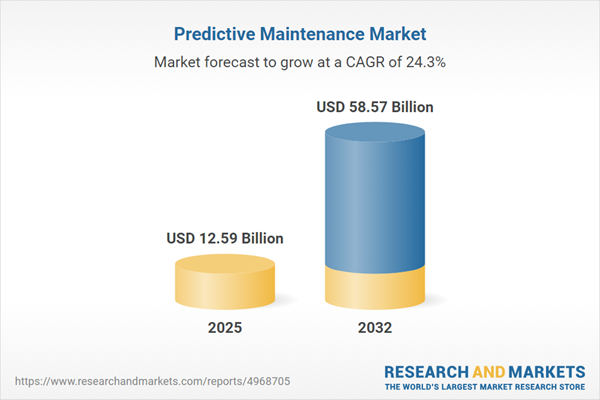Speak directly to the analyst to clarify any post sales queries you may have.
The predictive maintenance market enables senior executives to maximize asset reliability and operational efficiency by proactively addressing equipment issues. Organizations across key industries are turning to predictive maintenance solutions to stay ahead of operational challenges and ensure seamless workflow modernization.
Market Snapshot: Predictive Maintenance Market Size & Growth
The global predictive maintenance market is valued at USD 10.26 billion in 2024 and is expected to expand at a compound annual growth rate (CAGR) of 24.31%. Projections indicate that the sector will reach USD 12.59 billion by 2025 and USD 58.57 billion by 2032. Sectors including manufacturing, utilities, and transportation are fueling this robust growth by prioritizing asset reliability and operational streamlining. The momentum behind digital transformation and the need for advanced risk management is accelerating predictive maintenance adoption, helping organizations remain agile and competitive as business environments evolve.
Scope & Segmentation: Strategic Opportunities in Predictive Maintenance
- Offering: Solutions encompass industrial sensors, edge devices, analytics platforms, expert consulting, deployment support, and specialized training to drive optimization throughout the asset lifecycle.
- Technology: Core technologies span advanced analytics, artificial intelligence, IoT, digital twins, machine learning, and edge computing, automating monitoring while enhancing asset management and predictive capabilities.
- Pricing Model: Flexible approaches—subscription, usage-based, and perpetual licensing—allow enterprises to align investment with capital priorities for both short- and long-term planning.
- Implementation: Seamless integration is enabled by compatibility with legacy infrastructure as well as modern IT ecosystems, supporting consistent deployment in diverse settings.
- Connectivity: Wired, Wi-Fi, LPWAN, and cellular connections provide secure, real-time data exchange, ensuring reliable coverage for centralized and distributed assets.
- Application: Use cases include condition monitoring, failure detection, lifecycle management, predictive scheduling, and prescriptive analytics, equipping maintenance teams with actionable insights.
- Deployment Model: Cloud-based and on-premise options offer adaptability for regulatory compliance and operational customization, allowing alignment with internal IT strategies.
- Organization Size: Scalability accommodates both small businesses and multinational enterprises, addressing distinct maintenance and resource management requirements.
- Industry Vertical: Adaptability across verticals such as aerospace, chemicals, defense, food and beverage, mining, oil and gas, utilities, telecom, and transportation enables tailored asset management solutions.
- Regional Scope: Market offerings are customized for regulatory and commercial conditions in the Americas, EMEA, and Asia-Pacific to drive adoption and compliance across regions.
Predictive Maintenance Market: Key Takeaways for Senior Decision-Makers
- Early integration of predictive maintenance protocols reduces equipment failures, minimizing operational interruptions and enhancing long-term resilience for business continuity.
- Sensor-enabled assets combined with edge technologies convert data into actionable information, facilitating a shift from reactive to condition-based maintenance strategies.
- Collaboration with a network of technology providers mitigates risks tied to single-source dependency and promotes agility in responding to market shifts or operational changes.
- Unified efforts between operations, IT, and procurement teams enable a streamlined transition to predictive maintenance, driving effective implementation and optimal use of resources.
- Solutions designed for strong integration streamline scalability across diverse sites, supporting standardized best practices and efficient system expansion.
- Software-centric implementations simplify rollouts for organizations managing multiple locations, encouraging cohesive adoption of advanced maintenance strategies.
Tariff Impact: Optimizing Procurement and Supplier Strategies
Changes in tariffs and industry regulations through 2025 influence procurement approaches within the predictive maintenance sector. Organizations benefit from agile sourcing and diversified supply chains by partnering with regional technology vendors and prioritizing device-neutral solutions. These strategies help minimize exposure to trade policy fluctuations, reinforce supply chain stability, and support operational continuity across global markets.
Methodology & Data Sources
Findings in this report are derived from comprehensive interviews with senior executives, ongoing analysis of sector trends, and expert-reviewed research. Industry practitioners validate all insights to ensure actionable recommendations for leaders navigating predictive maintenance investments.
Why This Report Matters
- Enables strategic adoption of predictive maintenance, empowering organizations to foster strong supplier relationships and remain responsive to changing industry conditions.
- Delivers targeted benchmarks and guidance for procurement, planning, and compliance, aiding resource optimization throughout operational processes.
- Provides sector-specific and geographic insights for aligning technology deployments with distinct business and regulatory needs.
Conclusion: Advancing Predictive Maintenance Success
Investing in predictive maintenance enhances organizational adaptability and asset reliability, positioning businesses to address evolving challenges while pursuing operational excellence and steady growth.
Additional Product Information:
- Purchase of this report includes 1 year online access with quarterly updates.
- This report can be updated on request. Please contact our Customer Experience team using the Ask a Question widget on our website.
Table of Contents
3. Executive Summary
4. Market Overview
7. Cumulative Impact of Artificial Intelligence 2025
Companies Mentioned
The companies profiled in this Predictive Maintenance market report include:- Honeywell International Inc.
- International Business Machines Corporation
- Amazon Web Services, Inc.
- ASYSTOM SAS
- C3.ai, Inc.
- Databricks, Inc.
- DINGO Software Pty. Ltd.
- Fiix Inc. by Rockwell Automation, Inc.
- General Electric Company
- Hitachi, Ltd.
- Infineon Technologies AG
- Intel Corporation
- Limble Solutions, Inc.
- Micro Focus International PLC by Open Text Corporation
- Microsoft Corporation
- NVIDIA Corporation
- Oracle Corporation
- Robert Bosch GmbH
- SAP SE
- Schneider Electric SE
- Siemens AG
- TIBCO Software Inc. by Cloud Software Group, Inc.
- Uptake Technologies Inc.
- PTC Inc.
- Augury Inc.
- Google LLC by Alphabet Inc.
- H2O.ai, Inc.
- FSM Global
- Megger Group Limited
- Razor Labs Ltd
- Aurora Labs
- OMRON Corporation
- Nanoprecise
- GUIDEWHEEL
- Emerson Electric Co.
- Baker Hughes Company
- ABB Ltd.
Table Information
| Report Attribute | Details |
|---|---|
| No. of Pages | 186 |
| Published | October 2025 |
| Forecast Period | 2025 - 2032 |
| Estimated Market Value ( USD | $ 12.59 Billion |
| Forecasted Market Value ( USD | $ 58.57 Billion |
| Compound Annual Growth Rate | 24.3% |
| Regions Covered | Global |
| No. of Companies Mentioned | 38 |









